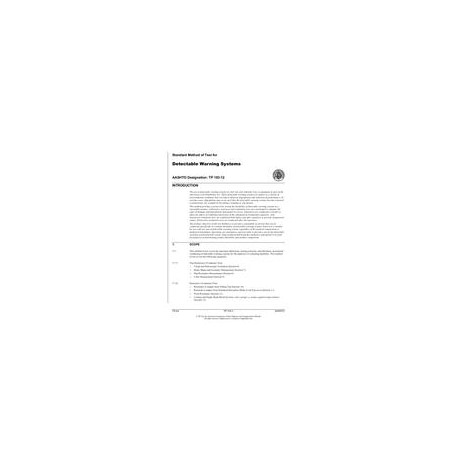Cart 0 Product Products (empty)
No products
To be determined Shipping
$0.00 Total
Product successfully added to your shopping cart
Quantity
Total
There are 0 items in your cart. There is 1 item in your cart.
Total products
Total shipping To be determined
Total
New Reduced price!  View larger
View larger
 View larger
View larger AASHTO TP 103-12
M00001429
New product
AASHTO TP 103-12 Standard Method of Test for Detectable Warning Systems
standard by American Association of State and Highway Transportation Officials, 2012
In stock
More info
Full Description
The use of detectable warning systems at curb cuts and vehicular ways is mandated as part of the Americans with Disabilities Act. These detectable warning systems are subject to a variety of environmental conditions that can lead to material degradation and reduction in performance. In extreme cases, degradation may occur such that the detectable warning systems become a hazard to pedestrians, for example by becoming a tripping or slip hazard.This method provides a protocol for testing the durability of detectable warning systems in a repeatable manner. Laboratory exposures and evaluation tests were developed to simulate the types of damage and degradation anticipated in service. Exposures are conducted cyclically to allow for effects of combined interaction of the simulated environmental exposures. Nondestructive evaluation tests are conducted both before and after exposures to provide comparative values. Destructive evaluation tests are conducted after the exposures.
The primary objective of this test method is to provide a repeatable set of tests that can be conducted specifically to evaluate durability of detectable warning systems. Each test is suitable for use with any type of detectable warning system, regardless of the material composition or method of attachment. Specimens are attached to concrete slabs to provide a test of the detectable warning system/sidewalk system. Data produced following this method is anticipated to be used for purposes of determining product durability and product comparison.
This method of test covers the specimen fabrication, testing protocols, and laboratory-accelerated weathering of detectable warning systems for the purposes of evaluating durability. This method of test covers the following categories:Non-Destructive Evaluation Tests Visual and Microscopic EvaluationDome Shape and Geometry Measurement Slip Resistance Measurement Color MeasurementDestructive Evaluation TestsResistance to Impact from Falling TupResistant to Impact from Simulated Snowplow Blade (Cold Exposure)Wear Resistance Coating and Single Dome Bond (Systems with coatings or surface applied single domes)Laboratory Accelerated Weathering - Exposure Regime (Hot and Cold Exposure Categories)High Temperature Thermal CyclingAbrasion ExposureFreeze/Thaw Durability (Cold Exposure Applications only)Ultraviolet Light Exposure

